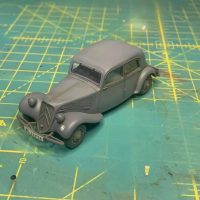Stinson Reliant SR-9 in 48th Scale by AMT/Round 2
The Stinson Reliant is a popular single-engine four- to five-seat high-wing monoplane manufactured by the Stinson Aircraft Division of the Aviation Manufacturing Corporation of Wayne, Michigan.
The Reliant is a high-wing, fixed-tailwheel monoplane. 1,327 Reliants of all types were made from 1933 to 1941, in different models, from SR-1 to SR-10. The final commercial model, the Stinson Reliant SR-10, was introduced in 1938.
Reliant production can be broken into two distinct types – the straight-wing Reliants (all models up to SR-6) and the gull-wing Reliants (all models from SR-7 and after, including the militarized V-77/AT-19), with there being little in common between the two groups of types. The straight-wing Reliant has a wing of constant chord and thickness which is supported by two struts each side with additional bracing struts. In contrast the taper-wing Reliant has the broadest chord and thickness of the wing at mid-span, with the outer wing trailing edge heavily angled forward and a rounded cutout on the leading-edge root, all supported by a single strut. The taper wing has a significant step up between the fuselage and the wing, and the changes in wing thickness gave it a distinct gull appearance from the front
Engine options for the -9-variant ranged from a 245 horsepower (183 kW) Lycoming R-680-B6 engine to the 450 horsepower (340 kW) Pratt & Whitney Wasp Junior.
If you wish to read all of the gory details of the build, you do so at the website, "Modeling Madness".
My observation of the kit are: That it is a product of its time. (1970s) It will take a LOT effort to make a contest worthy model. However, the thinking behind the engineering was ahead of the technology and the kit has much potential. The fit of the parts is positive, easing assembly. Detail, especially the wing ribs, is overstated. Given today's state of the art, a current manufacturer could produce a much better kit and include a good set of decals. This is a handsome subject and any modeler can produce a nice model.








Beautiful job on a simple, but nice kit. I do wish more manufacturers would produce more 1920s and '30s civilian civil and racing subjects using today's technology like you said, but with your skill you demonstrated the results possible with these older kits.
Thanks. I wonder how we can get the word out to manufacturers that there is a market for such kits.
A beautiful build indeed, John @jsummerford
You have chosen a nice scheme and applied it perfectly.
Thanks. Masking took about as long as building. I'm particularly proud of the the transition of the black paint from the fuselage to the trim of the fin.
Excellent result out of this elderly mold, John!
Congratulations!
Thanks. what makes these projects enjoyable is that they are not complicated--unless you make it so.
I have one of these awaiting the arrival of the Arctic Decals sheet for the American Airlines airplane.
Nicer work on this and a great result, John.
I envy you getting the decals. I couldn't find them, so I opted the simpler scheme. I'm sure you can get a great looking model with them.
Nice result…I know the kit and appreciate your effort..sadly, civil air seems if small interest to actual kit buyers or we might see more new kits
Thanks. Perhaps if more builds of civilian subjects appear on-line, new kits will appear.
Nice build - don't see many of these! Well done.
A real beauty, very well done. That kit is one of my favorite civil builds from way back. Too bad there's not more old classics like this among all the new wonder kits.
1 attached image. Click to enlarge.
Thanks. I appreciate your photo. I see that you have put in more effort than I did on mine.
Very nice build John.
Thanks. Now that my skills are much improved since the kit was first issued, it is was a much more enjoyable project.